I can’t remember any longer when I decided to set aside a week and go to Istanbul, but once I’d made up my mind, I bought the tickets, booked the hotel and started to plan for this trip like never before. In addition to reading several different guidebooks, I also read a book of Turkish fairy-tales. As I child I loved reading fairy-tales and I have lots of books with fairy-tales from all over the world, so their reading normally constitutes a regular type of my preparations for any new destination, as the case was this time. I also read a historical novel „Sokollu Mehmed Pasha“ (in Serbian) by Dušan Baranin and in this way I was getting acquainted with some of the main players and mentally entering the events taking place in the 16th-century Ottoman Empire. This was also the time when perhaps the most famous Ottoman architect Sinan was active. To this very day his accomplishments constitute some of the unavoidable places that must be visited when in Istanbul.
What I want to say is that I have not gone into that many details nor have I planned daily visiting routes for any of my earlier travels, as I have for this trip.
Although this certainly helped me to get acquainted in my head with the city and some of its landmarks, as I was sitting in the plane flying to this megalopolis (over 15 million inhabitants), I was not sure that this would be enough. Simply because everybody I had talked to about Istanbul had spoken with the greatest possible delight saying that this was a fantastic and magical city. EVERYBODY.
I planned this journey for the first half of October, since I though the main season would be over, while the temperatures would not be unpleasantly high. Also, I had agreed with my friend Sneža to join me. The flights were perfect, since we left on a Saturday morning, while the return was planned for next Sunday evening. In other words, we used a working week to its maximum, with the two flanking weekends and thus we came to eight nights and nine days. But, when planning the sightseeing I realised there was so much to see that I was not sure we would be able to visit it all well. On the other hand, I was also thinking that with this journey I would be creating an introduction into future detailed visits to Turkey, since this is an exceptionally picturesque, archaeologically, historically and culturally rich country, with amazing nature and, certainly not any less important, fantastic cuisine. I had already been to Turkey before, but all three times I went there for my summer vacations, always to the same place (exceptionally nice and perfect for a holiday), but nothing more than that. In other words, I was ready and resolute to turn the situation in my favour.
When I was choosing at which hotel I would book a room for us, in agreement with Sneža I decided to give us a treat. Neither to her nor to me staying at an expensive hotel is a priority, but this time around we opted for a somewhat pricy hotel since it was wonderfully positioned, in the part of the city called Sultanahmet, just a couple of minutes on foot from the Blue Mosque. The hotel definitely “bought” me with the photos on their site showing the restaurant at the top of their building from which it was possible to enjoy a wonderful view.
To start with I agreed with the hotel to arrange a direct transfer from the airport for us. The new airport is around 50 km away from the centre of the city and I thought that by the time the two of us figured out where we were, transferred by some form of public transportation to the centre (in October 2019 there was still no underground or train line to/from the new airport), found our bearings there and somehow got to the hotel (by public transport or a taxi), when I considered the time, the hassle and fiddling around, this was certainly a far simpler solution which was not necessarily significantly more expensive. The reason why I’m mentioning this at all is something that was the first for me. When I was arranging this transfer with the hotel, they told me that the driver would wait and that he would hold a board with some code since, apparently, it was no longer permitted, at least not in Turkey, that the names of passengers were written on those boards. I presume that this was a question of some security measure and/or “personal data protection.” But, this is the reflection of the world we live in today. Anyway, I wrote down the code in a safe and handy place and that was more or less it.
On the other hand, when we got to the airport, took our things and went out after the customs section, we did not see anyone with a board and the given code, but rather Sneža started to ask some people hanging around there and thus we finally located the one who was “waiting” for us. Well, not everything needs to be perfect and to go smoothly. The important thing was that we were transported to the hotel nicely and efficiently.
When we left our things at the room, we first had a coffee at the restaurant from which there was indeed a wonderful view at the top of the Blue Mosque and the Bosphorus, and under a certain angle it was possible to see Hagia Sophia as well. As I’ve said, it was precisely this position of the hotel that was the main reason why we had chosen it.
After that coffee, we went out and walked to the not too far Kapali Carsi, since the receptionist told us this was the best place to change money, as the exchange offices there do not charge any commission. In the vicinity of the Grand Bazaar, which is the other name for the Kapali Carsi, we passed by numerous shops with food, either savoury or sweet, and it all lured us intensively, but our plan was to go and eat a little later. Still, we could not resist and right after having changed the money we bought one big glass each of freshly squeezed pomegranate juice. This was the perfect season for something like this since the pomegranates were at their peak. I drank this large glass of juice unnaturally quickly, but it did not bother me in the least.
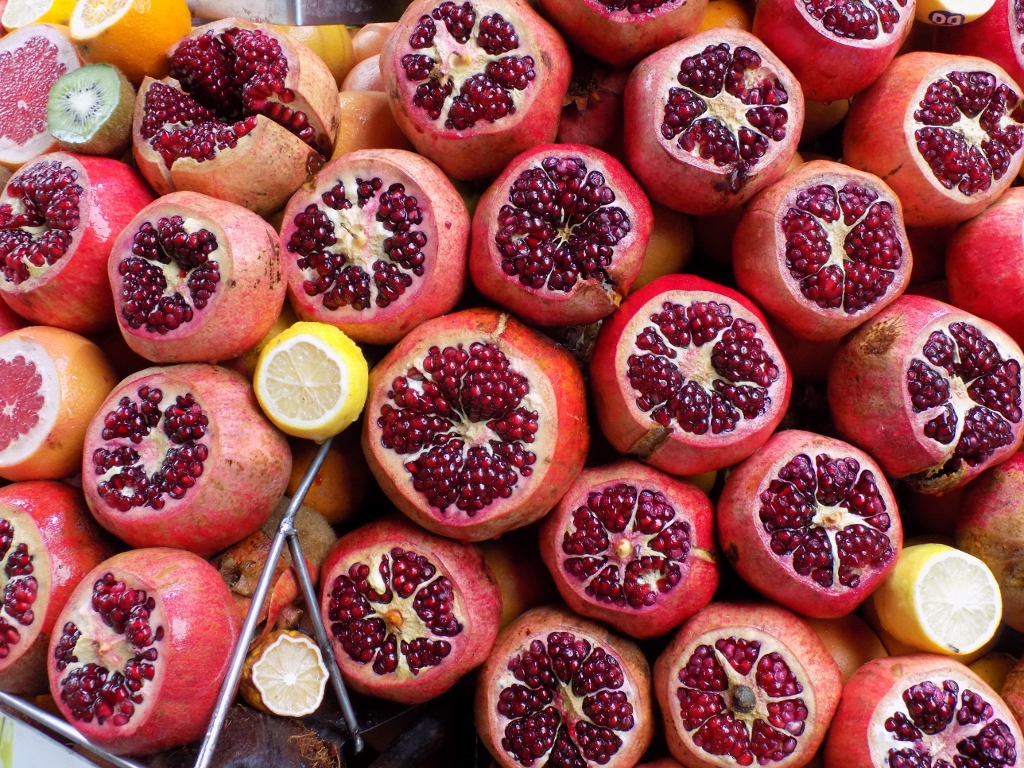 Pomegranates on one of the stalls where one can buy freshly squeezed juices
Pomegranates on one of the stalls where one can buy freshly squeezed juices
When we finished what we came there for, we went to the Sultanahmet Square, since there used to be a Carpet Museum which I wanted to visit. At least that was what I had seen in one of my (apparently ancient) guidebooks. As it turned out, however, the museum had been moved, so a man we asked explained to us where the museum actually was. That did not disconcert us in the least, but rather we started from the south end of the square, if I can designate it like that, to walk slowly towards the opposite end.
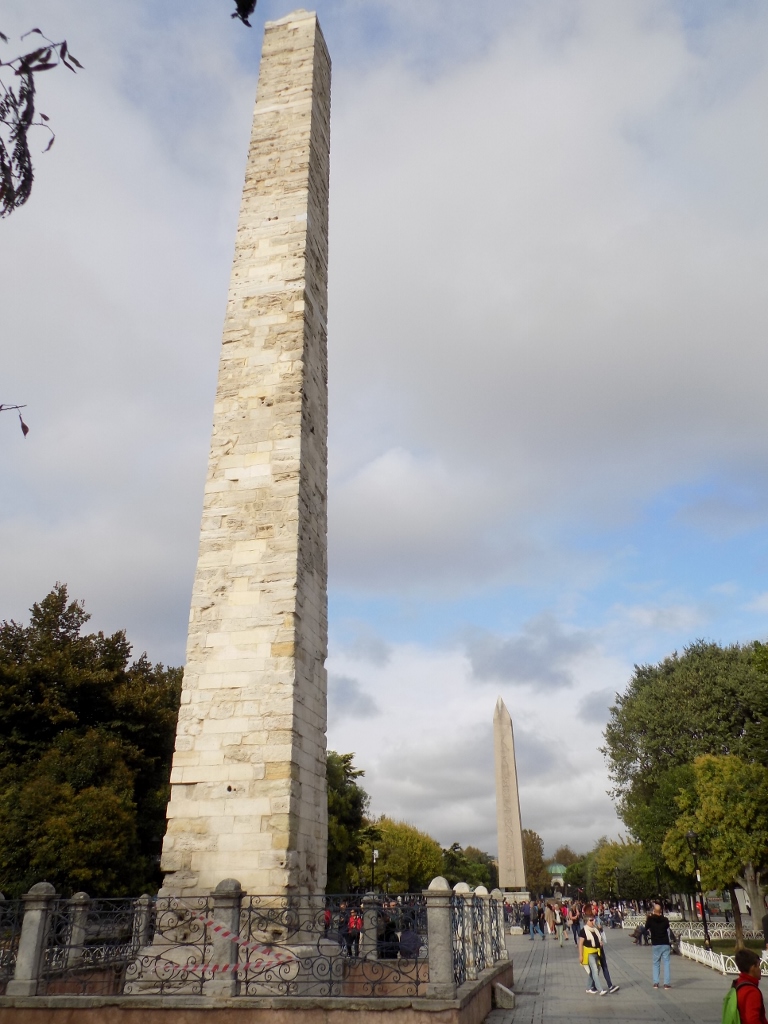 Sultanahmet Square: Walled Column and a little farther Obelisk of Theodosius
Sultanahmet Square: Walled Column and a little farther Obelisk of Theodosius
This entire square is actually located in the place where during the Roman times there used to be a Hippodrome, the place in which horse and chariot races used to be organised, and which used to be the centre of public entertainment both during the Roman times and later during the Byzantine period. Originally, it used to cover a much larger area than today, but the development of the city led to the construction of buildings that narrowed down the former Roman circus. Still, even today, this is a pretty and spacious square with interesting things that may be seen. To start with, there are three obelisks. All three of them are quite different by their nature and shape, and in fact only one of them is a proper obelisk. There is also the Sultan Ahmed Mosque, much better known under the name of the Blue Mosque, and on the opposite side there is also the Museum of Turkish and Islamic Arts. Still, apart from those columns that we were passing by anyway, the two of us were not interested at this point in time to do any other sightseeing, but rather we agreed to make a circle around in order to get acquainted with the surroundings and get an idea about where everything was and how much it was away from the other places.
Namely, Sneža had already been to Istanbul before, on several occasions, but always on business, so every time she would have only limited time for possible tourist visits, plus she hadn’t been there for a while and thus she enjoyed the memory-refreshing exercise. On the other hand, I had never been in Istanbul before, but I did have a rather unusual sensation – although I had never before seen anything of what I was seeing then, I still somehow felt I was in quite a familiar place. Perhaps this was contributed to by the very detailed preparations I had had or perhaps, and now I’m venturing into slightly esoteric assumption, Turkey and Istanbul, or “Tsargrad” as we historically used to call this city, belong after all to the collective memory of my nation and this may have been coming up to the surface of my consciousness.
Anyway, we first had a look at those three obelisks, i.e., three columns. The first one we came across was the Walled Column or Obelisk, followed by the Serpent Column and finally THE proper obelisk – the Obelisk of Theodosius.
As for the Walled Column, which is seen well in the photo above and which is 32 m tall, it is not know exactly when it was first built, but it was reconstructed in the 10th century by Constantine VII which renders the other frequent name of the column – Constantine Obelisk.
The Serpent Column, 8 metres tall, comes from the famous oracle in Delphi, Greece, from where Constantine the Great brought it here in 324. Originally, on the top of the column, heads of three snakes used to stand apart, since their bodies obviously wrap around the others creating a column in this way, but with time those heads deteriorated or were destroyed (the historic accounts are unclear about this). Still, a part of one head is nowadays kept at a museum.
And finally, the only proper obelisk which is almost 20 metres tall is nowadays called after Emperor Theodosius I from the 4th century who placed it here, but in fact is had been originally erected in Ancient Egypt, in Karnak to be more precise, by Tutmoses III around 1450 BCE in the honour of his father.
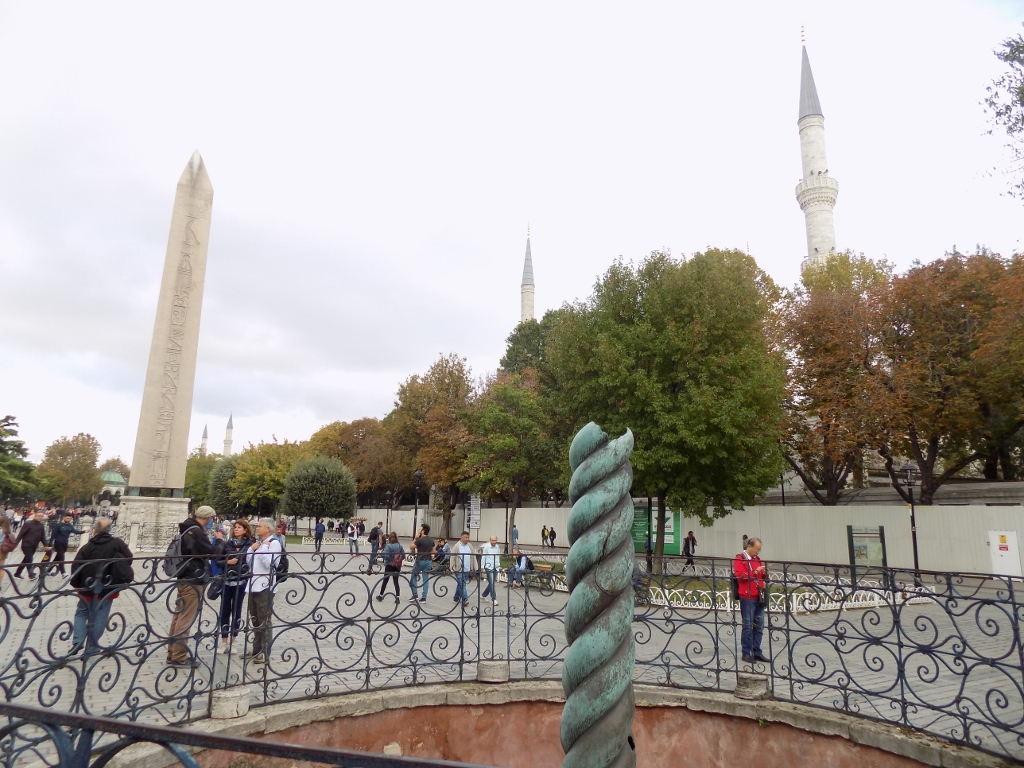 Sultanahmet Square: Serpent Column, Obelisk of Theodosius and minarets of the Blue Mosque on the right-hand side
Sultanahmet Square: Serpent Column, Obelisk of Theodosius and minarets of the Blue Mosque on the right-hand side
As one approaches the end of this elongated square, in-between treetops it is possible to see Hagia Sophia, former church, then mosque and nowadays a museum.
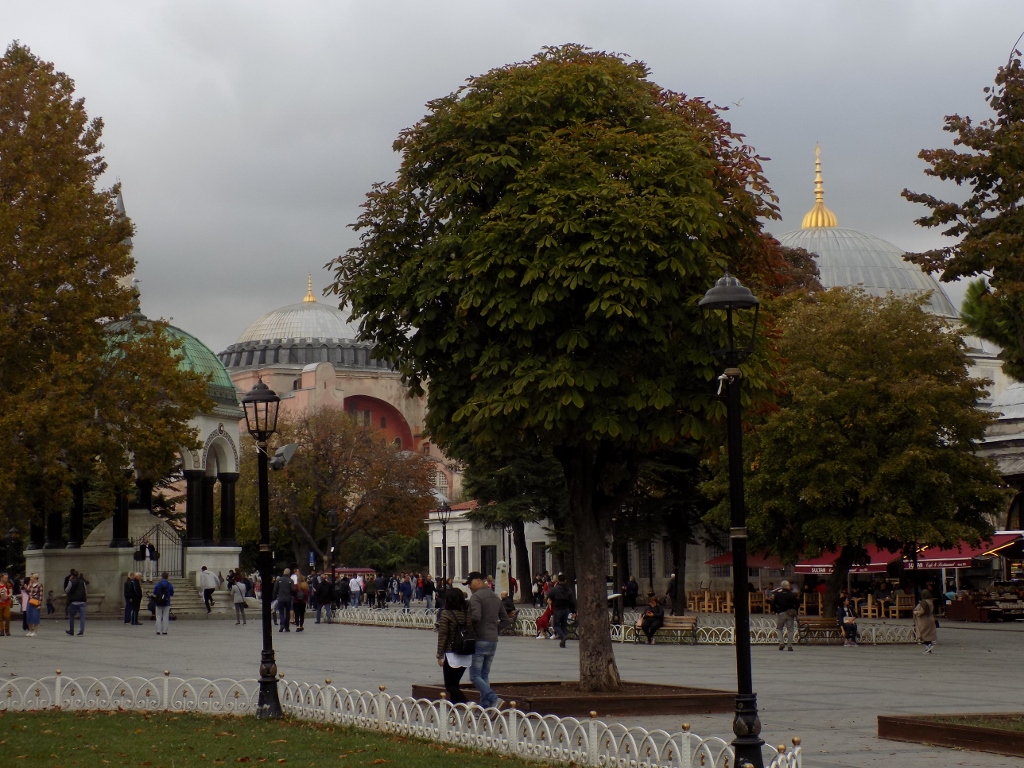 Sultanahmet Square: Hagia Sophia between treetops
Sultanahmet Square: Hagia Sophia between treetops
There, at the end of the Sultanahmet Square there is also the German fountain, a monument built at the end of the 19th century honouring the visit of Prussian King and German Emperor Wilhelm II, which symbolically celebrated the friendship between the Turks and the Germans.
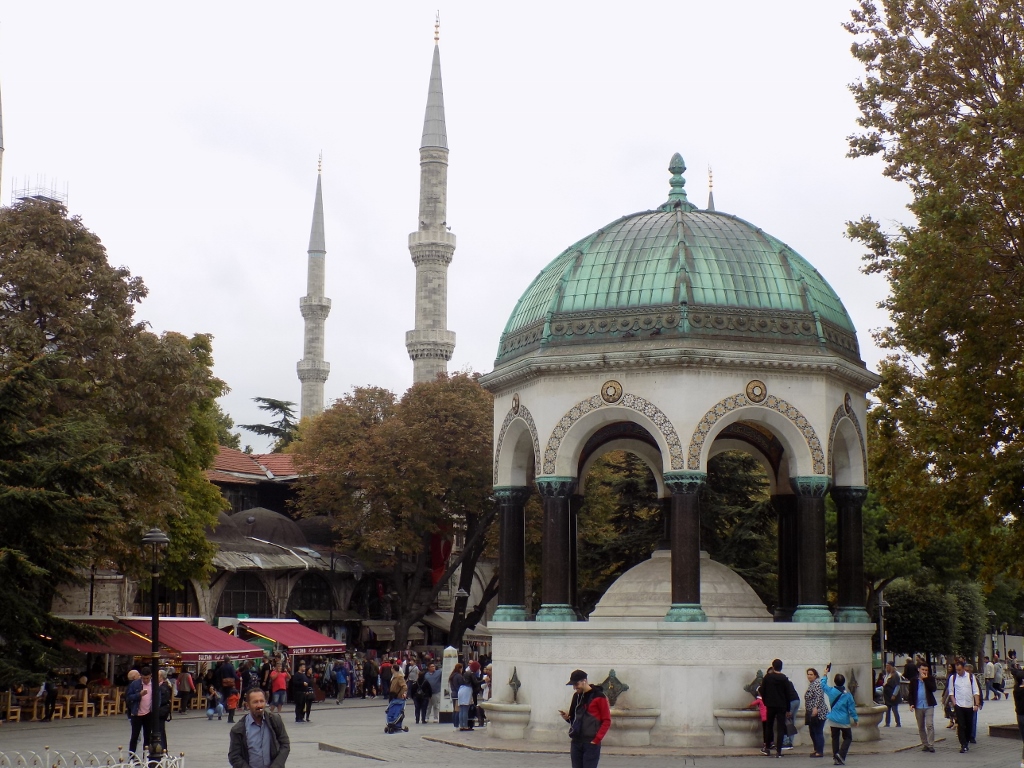 Sultanahmet Square: German Fountain and the minarets of the Blue Mosque
Sultanahmet Square: German Fountain and the minarets of the Blue Mosque
When we got to the end of the square, we continued leisurely to the entrance into the Hagia Sophia complex in order to see where we would go already the following morning and then we walked towards the Topkapi Palace. Our path actually led us precisely to the museum I wanted to visit earlier that afternoon, i.e., the Carpet Museum, but at this hour of the day it was already closed.
Looking at the gorgeous, exotic buildings we were passing by or we came across, I realised what it was that I additionally liked – on the one hand I was surrounded by the Orient, another culture that is so intensely permeated by the Islam, and yet I did not feel too foreign. Perhaps because the Islam practiced here is not too strict and so, if it hadn’t been for the specific architecture that was around me, I could have easily thought I was somewhere in Europe.
Opposite the Carpet museum there is also one of the gates that may be used to access the official entrance into the Topkapi Palace and then we went to see another access on the other side where we planned to come the following day, after which we decided to go again to the surroundings of the Kapali Carsi in order to eat there.
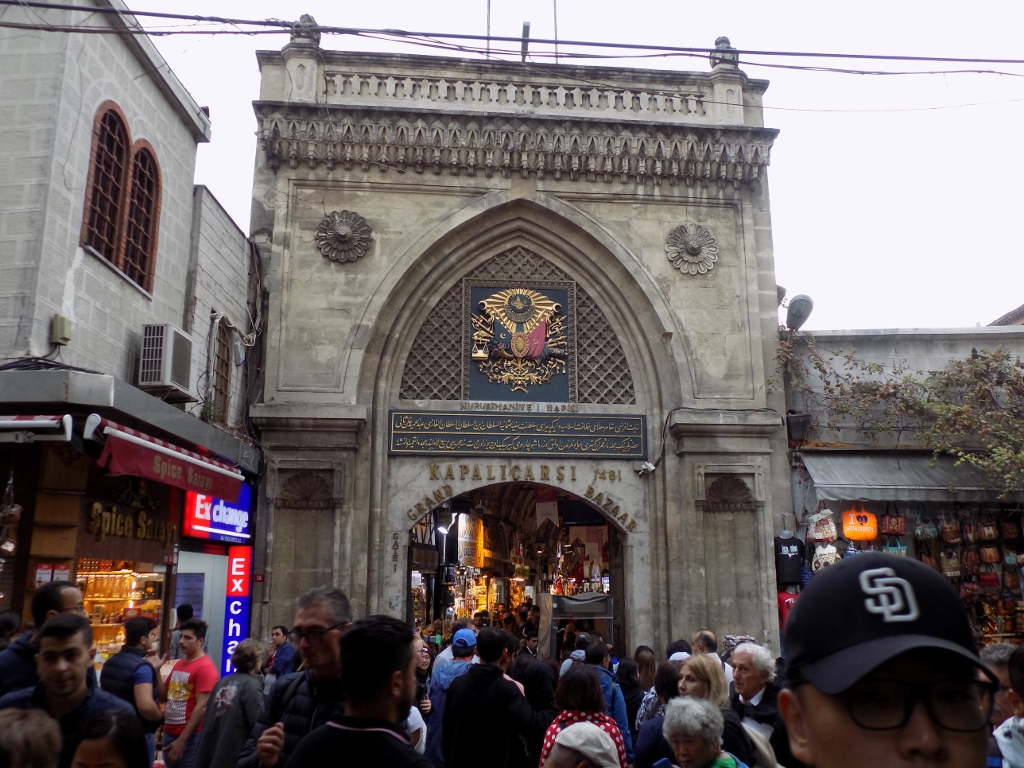 One of the entrances into the Kapali Carsi
One of the entrances into the Kapali Carsi
So we did and then we walked a little around the Grand Bazaar. Needless to say, there is a myriad of different shops, but we did not venture into the side lanes, deciding rather to stick to the main street.
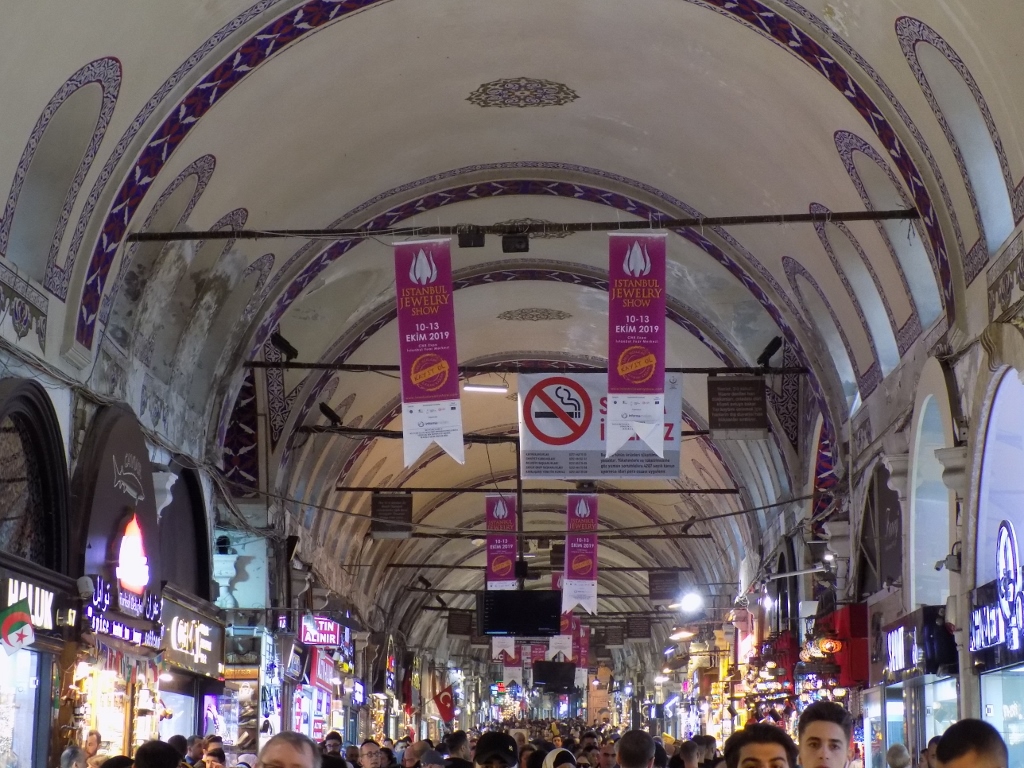 Interior of the Kapali Carsi
Interior of the Kapali Carsi
As we were passing by, I was captivated by the goldsmiths’ windows. Not necessarily because I love gold and jewellery very much, but I was simply fascinated by the concentration of this noble metal processed in very lavish forms.
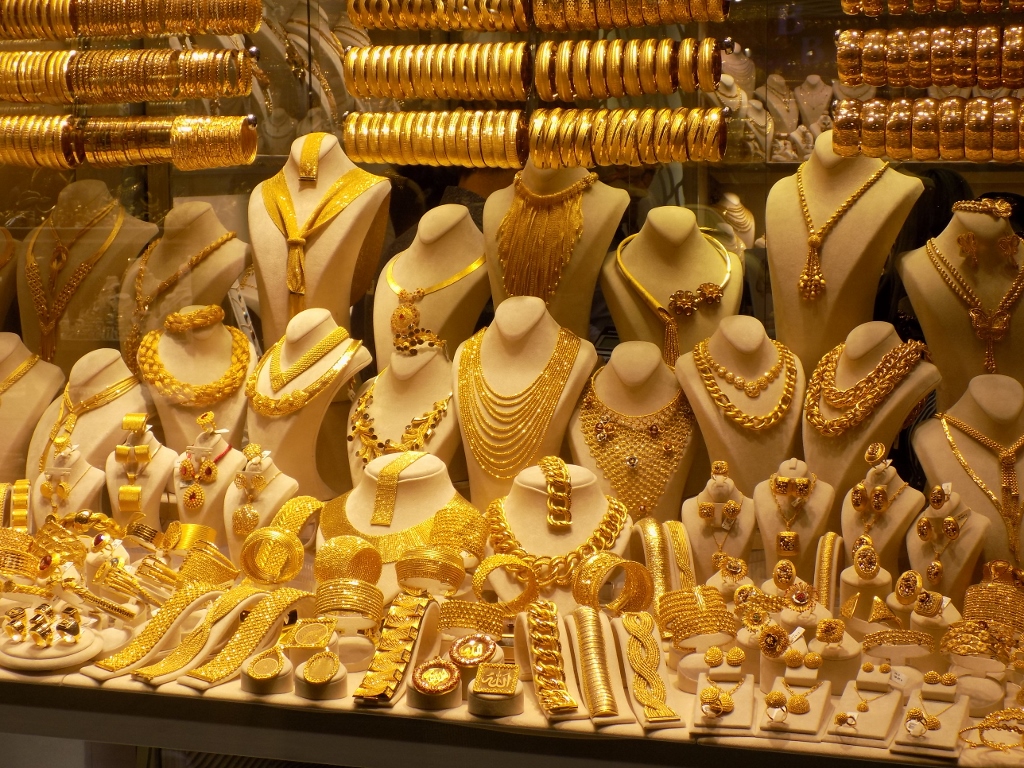 A shop-window of a goldsmith in the Kapali Carsi
A shop-window of a goldsmith in the Kapali Carsi
Following this walk, we finally sat down at a restaurant close to the Grand Bazaar. To start with we took different versions of the meze, after which we shared a main course. We had to leave some space for the wonderful baklava that we ate a little later in one of the pastry shops.
A little bit more of walking around and we were ready to go back to our room to have rest in order to gain the strength for the visits I had planned for the next day.
As planned, we started by being at Hagia Sophia a little before 9 and the tickets still did not start to be sold, but the line was already quite long. We agreed on the spot that we did not want to wait in such a long line and that we would rather buy slightly more expensive ticket as a part of the fast track system, but while we were waiting to buy that type of ticket, we abruptly decided to buy a museum pass valid for five days and covering numerous museums. On the one hand, it pays off rather quickly and on the other, which is much more important, you don’t wait in lines anywhere covered by the pass in order to buy the entry tickets, but rather you immediately move on to the security check. So, this is about a very significant saving of time and even the money provided you want to visit a large number of museums and the two of us ended up being very pleased with this decision.
So, Hagia Sophia...
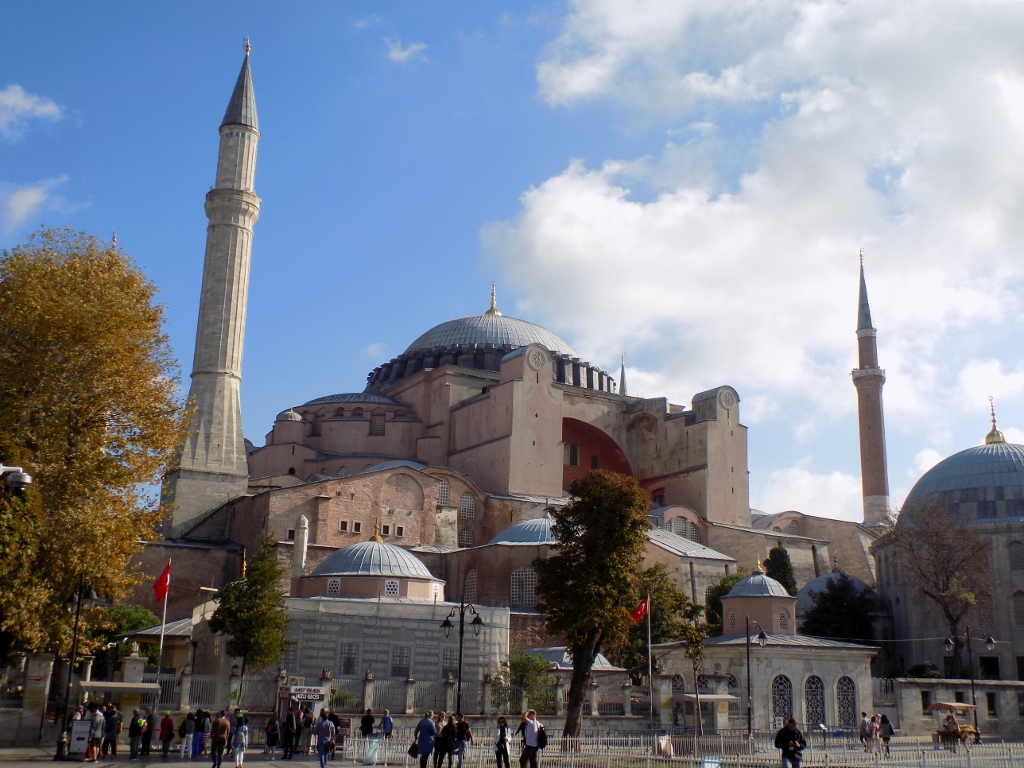 Hagia Sophia
Hagia Sophia
The first church at this site was consecrated in 360 CE during the reign of Emperor Constantius II, the son and heir of Constantine the Great who in the 4th century declared the ancient town of Byzantium to be the capital of the Eastern Roman Empire. It was after him, Constantine the Great (by the way, born in the Roman city of Naissus, present-day Niš in Serbia), that the city was called Constantinople. That ancient church burned on several occasions, so it was restored in 415, but eventually ended up being totally demolished by the big fire of the 6th century. Emperor Justinian I ordered the construction of a new church that surpassed everything that had been attained in the Christian world until that time and this construction was completed in 537. The earlier church in this place was already named Hagia Sophia (in Greek), i.e., St Sophia’s, which means that the church was dedicated to the Holy Wisdom. Today, the other name that is often used is Ayasofya which is the Turkish version of the original name.